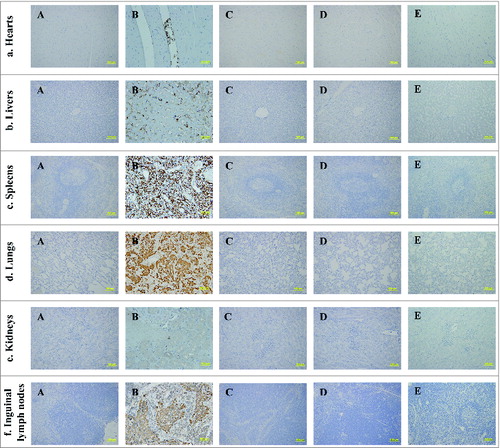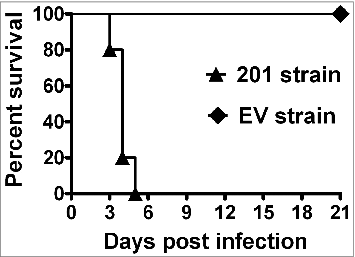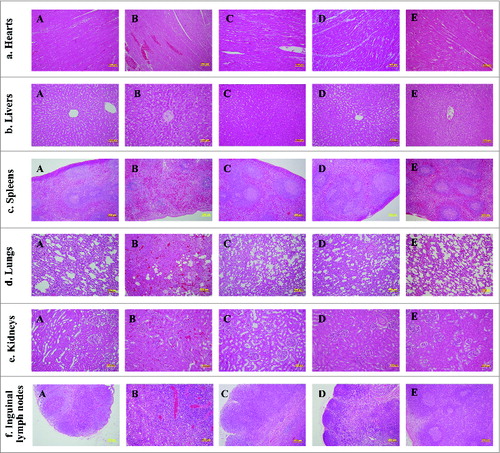Figures & data
Figure 1. Post-mortem examination of gross changes in the organs from the animal infected with the Y. pestis Microtus 201 or the vaccine EV. (A and B, a and c) Photos taken from the animals infected intravenously with approximately 109 CFU of the Y. pestis Microtus 201 and the vaccine EV. (A and B, b and d) Photos taken from the animals infected intravenously with approximately 1010 CFU of the Y. pestis Microtus 201 and the vaccine EV.

Table 1. Microbiological examination of tissue bacterial load in the Chinese-origin rhesus macaques following Y. pestis infection
Figure 2. The F1 antigen of Y. pestis was identified by immunohistochemitry staining. Bacteria were visualized as those expressing F1 antigen (brown and yellow stain). (A) Tissue sections from the animals infected intravenously with 9 × 108 CFU of the Y. pestis Microtus 201. (B) Tissue sections from the animals infected intravenously with 1.28 × 1010 CFU of the Y. pestis Microtus 201. (C) Tissue sections from the animals infected intravenously with 9.6 × 108 CFU of the vaccine EV. (D) Tissue sections from the animals infected intravenously with 1.5 × 1010 CFU of the vaccine EV. (E) Tissue sections from one normal animal that was neither immunized with the Y. pestis Microtus 201 or the EV vaccine. Numerous bacteria were observed in the tissue of hearts (a), livers (b), spleens (c), lungs (d), kidneys (e) and lymph nodes (f) of the dead animals after infection with approximately 1010 CFU of the Y. pestis Microtus 201 (B). No bacterium was found in other groups of animals (A, C and D) and the control animal (E).

Figure 3. Survival analysis of the Chinese-origin rhesus macaques after intravenous infection with approximately 1010 CFU of the Y. pestis Microtus 201 and the vaccine EV.

Figure 4. Histopathologic observation of the tissues from the animals infected with the Y. pestis Microtus 201 and the vaccine EV. Tissue sections were stained with hematoxylin and eosin for pathological examination after infection with Y. pestis. (A) Tissue sections from the animals infected intravenously with 9 × 108 CFU of the Y. pestis Microtus 201. (B) Tissue sections from the animals infected intravenously with 1.28 × 1010 CFU of the Y. pestis Microtus 201. (C) Tissue sections from the animals infected intravenously with 9.6 × 108 CFU of the vaccine EV. (D) Tissue sections from the animals infected intravenously with 1.5 × 1010 CFU of the vaccine EV. (E) Tissue sections from one normal animal.

